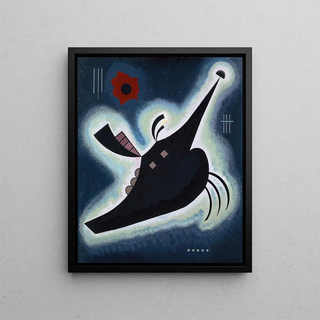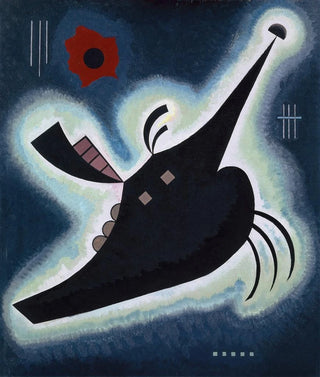Art print | Pointu noir - Wassily Kandinsky


View from behind

Frame (optional)
Pointu noir art print - Wassily Kandinsky – Captivating introduction
In the vibrant universe of modern art, certain works stand out for their ability to transcend time and capture the very essence of creativity. Among these iconic pieces, "Pointu noir" by Wassily Kandinsky emerges as an essential masterpiece. This canvas, which belongs to the expressionist movement, invites viewers on a visual and emotional journey, where each shape and color seems to pulse with its own energy. The art print of this work offers a unique opportunity to immerse oneself in Kandinsky's colorful and abstract universe, while revealing the subtleties of his artistic language.
Style and uniqueness of the work
"Pointu noir" is characterized by a bold color palette and dynamic geometric shapes that intertwine to create a harmonious composition. The choice of black, as a focal point, immediately draws the eye and sparks a multitude of interpretations. The lines and curves surrounding it evoke perpetual movement, as if the piece is in constant evolution. Kandinsky, as a pioneer of abstraction, seeks to express emotions and sensations rather than represent the world figuratively. This innovative approach allows the viewer to feel an intimate connection with the work, inviting them to explore their own emotions and reflections in front of the art. The richness of the hues and the depth of the forms make "Pointu noir" a piece that is not just to be contemplated, but that actively engages the viewer in an interactive dialogue.
The artist and his influence
Wassily Kandinsky, born in Russia in 1866, is often regarded as one of the pioneers of abstract art. His artistic career is marked by an unceasing quest for harmony between color and form, inspired by music and human emotions. Kandinsky firmly believed that each color had an emotional and spiritual resonance, and he endeavored to translate this idea into his work. His influence on the development of modern art is undeniable, paving the way for many artists who followed in his footsteps. By integrating elements of spirituality and philosophy into his work, he redefined

Matte finish

View from behind

Frame (optional)
Pointu noir art print - Wassily Kandinsky – Captivating introduction
In the vibrant universe of modern art, certain works stand out for their ability to transcend time and capture the very essence of creativity. Among these iconic pieces, "Pointu noir" by Wassily Kandinsky emerges as an essential masterpiece. This canvas, which belongs to the expressionist movement, invites viewers on a visual and emotional journey, where each shape and color seems to pulse with its own energy. The art print of this work offers a unique opportunity to immerse oneself in Kandinsky's colorful and abstract universe, while revealing the subtleties of his artistic language.
Style and uniqueness of the work
"Pointu noir" is characterized by a bold color palette and dynamic geometric shapes that intertwine to create a harmonious composition. The choice of black, as a focal point, immediately draws the eye and sparks a multitude of interpretations. The lines and curves surrounding it evoke perpetual movement, as if the piece is in constant evolution. Kandinsky, as a pioneer of abstraction, seeks to express emotions and sensations rather than represent the world figuratively. This innovative approach allows the viewer to feel an intimate connection with the work, inviting them to explore their own emotions and reflections in front of the art. The richness of the hues and the depth of the forms make "Pointu noir" a piece that is not just to be contemplated, but that actively engages the viewer in an interactive dialogue.
The artist and his influence
Wassily Kandinsky, born in Russia in 1866, is often regarded as one of the pioneers of abstract art. His artistic career is marked by an unceasing quest for harmony between color and form, inspired by music and human emotions. Kandinsky firmly believed that each color had an emotional and spiritual resonance, and he endeavored to translate this idea into his work. His influence on the development of modern art is undeniable, paving the way for many artists who followed in his footsteps. By integrating elements of spirituality and philosophy into his work, he redefined






